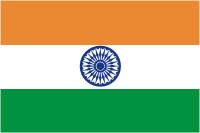 The Buddhist caves at Ajanta are perhaps the most significant site in the state of Maharashtra outside of Mumbai (formerly Bombay). It, like the rock-cut temples at Ellora, are listed on the UNESCO world heritage sites and are the home to some of the oldest known paintings and frescoes in Asia, dating back to 200 BC. The caves remained in somewhat obscurity until 1819 when a British hunting party apparently came across them in their travels. Although the caves are completely isolated in the hills, I find it hard to believe that not one of the 1.2 billion Indians living here didn't know about them!
The Buddhist caves at Ajanta are perhaps the most significant site in the state of Maharashtra outside of Mumbai (formerly Bombay). It, like the rock-cut temples at Ellora, are listed on the UNESCO world heritage sites and are the home to some of the oldest known paintings and frescoes in Asia, dating back to 200 BC. The caves remained in somewhat obscurity until 1819 when a British hunting party apparently came across them in their travels. Although the caves are completely isolated in the hills, I find it hard to believe that not one of the 1.2 billion Indians living here didn't know about them! We hired a car in Aurangabad (an awesome guy named Aleem) and traveled to Ajanta which is located about 100 km north of the city. We took a leisurely stroll through the 30 caves which took the better part of a day - most of the caves had elegant pillars and statue-type reliefs from the cave walls. Many of the frescoes were in good shape - which is amazing given that they were done using completely natural dyes and pigmentation. The detail in the art is astounding given that much of the work was done on the ceilings (I'm thinking Michelangelo and the Sistine Chapel) of these cave temples and the fact that most of them have endured for over two thousands of years.
We hired a car in Aurangabad (an awesome guy named Aleem) and traveled to Ajanta which is located about 100 km north of the city. We took a leisurely stroll through the 30 caves which took the better part of a day - most of the caves had elegant pillars and statue-type reliefs from the cave walls. Many of the frescoes were in good shape - which is amazing given that they were done using completely natural dyes and pigmentation. The detail in the art is astounding given that much of the work was done on the ceilings (I'm thinking Michelangelo and the Sistine Chapel) of these cave temples and the fact that most of them have endured for over two thousands of years. Evan again made sport of calling out each and every Buddha that he saw ("there's a Buddha and there's another Buddha..."), and it was fun to watch him run around and enjoy the caves since they were nice and cool.
Evan again made sport of calling out each and every Buddha that he saw ("there's a Buddha and there's another Buddha..."), and it was fun to watch him run around and enjoy the caves since they were nice and cool.On a separate note I've been corrected numerous times by my students (at KVT) for my pronunciation of Buddha:
"No sir, it's Bood-THA!" (with a strong accent on the second syllable).



No comments:
Post a Comment